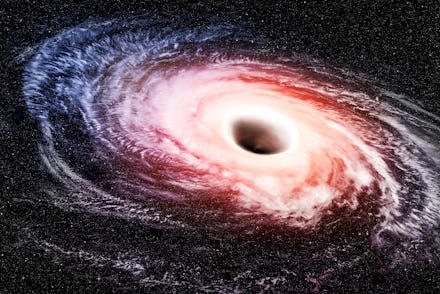Supermassive black hole suddenly lights up, definitely seems chill and normal

Black holes are known for being the dark parts of space with extremely intense gravity. Nothing can escape them — not even light. So what does it mean when a black hole suddenly starts 'flashing'? This is the question scientists posed in a recent report about an unusual event that happened in May, when a supermassive black hole brightened for two hours before dimming again.
The supermassive black hole, called 'Sagittarius A*,' is located in the center of our galaxy, the Milky Way. At 26,000 light years away, no one can see it with their own eyes, nor is it visible with an average telescope. Astronomers have to use special, infrared equipment such as the ones at the Keck Obsesrvatory in Mauna Kea, Hawai'i.
On Aug. 10, UCLA astronomer Tuan Do and his colleagues reported on the unusual black hole activity that occurred in May. While observing Sagittarius A*, the black hole became 75 times brighter than usual for about two hours before dimming again. Although these 'flashes' aren't entirely unusual for the black hole, this particular flash reached a brightness that astronomers haven't seen before, stated Do.
In an email to Vice, Do added that "something unusual might be happening this year because the black hole seems to vary in brightness more, reaching brighter levels than we've ever seen in the past."
The last notable flare up from Sagittarius A* was reported in 2015 by NASA. At the time, scientists hypothesized that the flash was due to an asteroid coming too close to the center. Another theory involved magnetic fields that became entangled, creating a bright flash of x-rays.
Do's team also have their own theories about this particular flash. Another star could have come within proximity of the supermassive black hole, messing with the gasses enough to create the flareup. It could also be a very delayed reaction to a dust/gas cloud colliding with the center.
Either way, Do and other astronomy teams are eager to figure out why Sagittarius A* is flickering like this, if it's just temporary activity, or if there's something going on with what's being drawn into the black hole.
"Many astronomers are observing [Sagittarius A*] this summer," Do told Vice. "I'm hoping we can get as much data as we can this year before the region of the sky with [Sagittarius A*] gets behind the Sun and we won't be able to observe it again until next year."
Our local, Milky Way, black hole isn't the only one turning heads this year. In a galaxy 700 million light years away, called Holm 15A, scientists have discovered an area that houses the largest black hole ever discovered. This black hole is at least 10,000 times larger than Sagittarius A*, and nine times larger than what scientists had previously measured. Thanks to technological advancements, astrologists were able to correct their earlier measurements.
Studying black holes helps researchers understand how galaxies form, exist, and then die. They can also help scientists better understand gravity and prove or disprove theories about gravity. A recent example was reported in July, when Sagittarius A* was used as a subject to put Einstein's theory of general relativity to the test. Despite being formulated during a time when humans didn't even know about black holes, the measurement of Sagittarius A*'s gravity only ended up proving Einstein's theory mostly correct.
However, his theory only scratched the surface of the gravity contained by a black hole. Astronomers are hoping further studies can help them move past Einstein's theory and create a theory that will better explain the nature of these supermassive black holes, giving us a clearer understanding about the universe we live in.